Lion850
National Hazard
   
Posts: 514
Registered: 7-10-2019
Location: Australia
Member Is Offline
Mood: Great
|
|
Report on making chromium chloride CrCl3.6H2O
I wanted to make another green compound and after reading a bit decided to go for chromium chloride as the hexahydrate is green and it seemed quite
stable in air. My starting materials was chromium acetate and concentrated hydrochloric acid.
- 20g chromium (iii) acetate (black salt) in 30g water and stir till dissolved in a black solution.
- Slowly add 35g hydrochloric acid while stirring.
- Heat to around 70C while stirring to reduce volume. Strong vinegar smell, and although the bulk solution appeared dark the splashes was green.
- Reduce total volume to around 35ml by steaming down, then transfer to desiccator.
- In desiccator 48hrs, vacuum pulled few times a day and sitting on a bed of sodium hydroxide.
- Volume was less but still a liquid after 48 hours.
- Put on steam bath for 6 hours. Volume much reduced, now a thick oily dark liquid. Suspect this is the hexahydrate that melts at 83C according to
wikipedia. No smell at all which to me was a sign that all acid was driven off.
- Remove from steam bath and leave on bench overnight. The next morning there was a solid that was black outside, more green inside but still a bit
wet inside, this was then broken up:
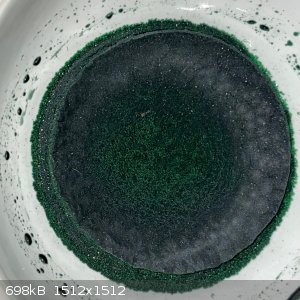
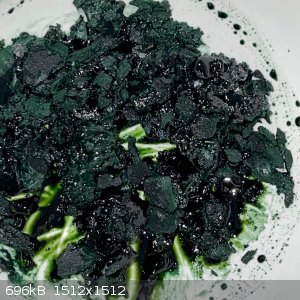
- Put the dish in the direct sun for 6 hours. This dried the contents into a very hard mass, green inside with a black crust. Broke this up with a
mortar, with some difficulty:
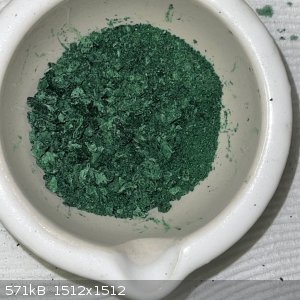
- Total recovery was 20g, which is a yield of just over 80%.
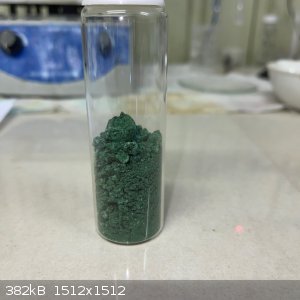
Cleaning the equipment shows that the product easily dissolved in water into a lovely dark green solution.
Question: I have a lot of CrO3 and I was wondering if I could have used this instead of the chromium acetate. But will reacting CrO3 and HCl give me
CrCl3 and Cl2 or will I get CrO2Cl2 instead?
|
|
|
woelen
Super Administrator
        
Posts: 7976
Registered: 20-8-2005
Location: Netherlands
Member Is Offline
Mood: interested
|
|
Using CrO3 for making pure CrCl3.6H2O is not such a good idea. At low concentrations of HCl, CrO3 does not readily oxidize it. Even after prolonged
heating in excess dilute (e.g. 10%) HCl only part of the CrO3 will have been reduced to CrCl3.
In concentrated fuming HCl you get CrO2Cl2 (you can see orange vapors), but also quite some CrO3 will oxidize the HCl to Cl2, especially if the mix is
heated somewhat. But getting a purely green solution (and not olive green, because then you still have some hexavalent chromium in solution) requires
heating and consequential dealing with nasty HCl fumes, with a little CrO2Cl2 mixed in. Not pleasant at all.
You could make CrCl3 from CrO3 and HCl if you use formic acid as reductor. The oxidation product is CO2 and excess formic acid can be removed by
heating. Be prepared though, that this reaction also tends to be somewhat slow and incomplete. So, again, you need some heating.
A very fast acting reductor is SO2 (or sulfite, if added to HCl), but the disadvantage is that this introduces extra ions in the mix, which are not
easily removed.
|
|
|
Lion850
National Hazard
   
Posts: 514
Registered: 7-10-2019
Location: Australia
Member Is Offline
Mood: Great
|
|
Thanks Woelen! I must figure out what I can do with my CrO3, I have some 500g which I got cheap - it was a case of take all, or nothing.
|
|
|
woelen
Super Administrator
        
Posts: 7976
Registered: 20-8-2005
Location: Netherlands
Member Is Offline
Mood: interested
|
|
CrO3 actually is quite an interesting chemical. Some nice demos can be done with it (e.g. igniting ethanol by dripping a few drops on solid CrO3), but
it also is useful for many oxidations.
You can also use it to make ammonium dichromate, which also can be used for nice demos. Ammonium dichromate easily is made by dissolving the CrO3 in
slight excess of ammonia and then letting the liquid evaporate in a luke warm place. Orange ammonium dichromate will be left behind.
Making ammonium chromate is much more difficult. It is not stable in air, it slowly loses ammonia and is converted to ammonium dichromate. In a closed
vessel though, it can be kept around, but on opening the vessel you smell ammonia.
You can also make interesting compounds like KCrO3Cl, potassium chlorochromate, by dissolving KCl in 25% HCl and adding a solution of CrO3 in icecold
25% HCl. Crystals of KCrO3Cl will settle at the bottom. Keep the liquid ice cold if you want pure KCrO3Cl, otherwise some hexavalent chromium is
reduced to trivalent chromium and then your product becomes brown-orange instead of bright orange.
Simplest things to make are K2CrO4 and K2Cr2O7 if you have KOH or K2CO3. Both chemicals can be easily recrystallized from distilled water to get
really pure compounds with beautiful bright yellow and bright orange colors.
But do keep some CrO3 around. It is useful on its own, especially in some organic redox reactions. Others can jump in in this thread with more
knowledge on that subject.
One word of warning though: Hexavalent chromium is a know carcinogen, when inhaled (e.g. think of dust, or gaseous CrO2Cl2). CrO3 does not give off
dust, it is too hygroscopic, but K2Cr2O7, (NH4)2Cr2O7 and K2CrO4 all are really non-hygroscopic free flowing solids, which easily can lead to
formation of dust, when scraped from a glass surface, or when handled as dry powder. Besides being a carcinogen, hexavalent chromium may also lead to
allergic reactions, when it comes in contact with skin. This differs from person to person. I myself am not sensitive to this (I know from
experience), but some people can suffer from nasty rashes.
[Edited on 15-9-21 by woelen]
|
|
|
Texium
Administrator
       
Posts: 4508
Registered: 11-1-2014
Location: Salt Lake City
Member Is Offline
Mood: PhD candidate!
|
|
Suffice it to say, you’d make all the organic chemists here really sad if you were to waste the oxidation potential of CrO3 just to make
some Cr(III) salts.
It would be a different story if you used it for something like a Jones oxidation and then recovered the leftover Cr(III).
[Edited on 9-15-2021 by Texium]
|
|
|
teodor
National Hazard
   
Posts: 872
Registered: 28-6-2019
Location: Heerenveen
Member Is Offline
|
|
I did several experiments trying to convert this "green" chromium chloride which is actually [CrCl2(H2O)4]Cl*2H2O to chrome alum. This is not easy
because you have to pull 2 chlorine atoms that are inside the complex. After discussion with Bedlasky here we thought that the most practical way is
to convert the chloride to hydroxide but what is interesting, slight modifications to a procedure gave completely incompatible results, so I actually
was unable to make any alum crystals. So this is not straightforward but some people can do it from the first try (Bedlasky). I did two or three and
failed.
But I did experiment with growing nice crystals of chromium chloride out of water solution with help of different organic solvents. Tert-butyl alcohol
and butyl acetate gave very nice crystals on long standing. In some cases, the complex was converted to the violet form [Cr(H2O)6Cl3. Unfortunately,
my labels from the tubes were washed out by the weather (I kept them outside), so I was unable to restore any procedures. But you can give it a try to
butyl acetate. Probably you will get some interesting results in several weeks or so.
The last experiment which I performed was dissolving Cr in HCl solution in methanol. By its appearance, it is similar to the green form which you got.
|
|
|
S.C. Wack
bibliomaster
    
Posts: 2419
Registered: 7-5-2004
Location: Cornworld, Central USA
Member Is Offline
Mood: Enhanced
|
|
Quote: Originally posted by Lion850  | | Question: I have a lot of CrO3 and I was wondering if I could have used this instead of the chromium acetate. But will reacting CrO3 and HCl give me
CrCl3 and Cl2 or will I get CrO2Cl2 instead? |
Yes.
The preparation is in my scan of Biltz and Biltz.
Perhaps a reducing agent such as alcohol can be added, giving a side product of acetaldehyde.
[Edited on 15-9-2021 by S.C. Wack]
|
|
|
maldi-tof
Harmless

Posts: 36
Registered: 3-4-2019
Member Is Offline
|
|
If you add H2O2 to your CrO3 and HCl, you will get CrCl3. The key point here is the concentration/crystallization.
|
|
|
woelen
Super Administrator
        
Posts: 7976
Registered: 20-8-2005
Location: Netherlands
Member Is Offline
Mood: interested
|
|
Quote: Originally posted by S.C. Wack  | Quote: Originally posted by Lion850  | | Question: I have a lot of CrO3 and I was wondering if I could have used this instead of the chromium acetate. But will reacting CrO3 and HCl give me
CrCl3 and Cl2 or will I get CrO2Cl2 instead? |
Yes.
The preparation is in my scan of Biltz and Biltz.
Perhaps a reducing agent such as alcohol can be added, giving a side product of acetaldehyde.
[Edited on 15-9-2021 by S.C. Wack] |
You definitely need a reducing agent, as I already wrote in my previous
post. I also have been thinking of ethanol (I have done that reaction myself quite a few times), but you also get some acetic acid, especially if
concentrations of CrO3 are high. Acetic acid will be harder to remove, because acetate ion also is a good coordinating agent for chromium(III).
Fortunately, it helps that the solution is strongly acidic. At such low pH, the formation of acetato complexes most likely is less favorable and then
the acetic acid could be driven off by heating. You should not heat too strongly though, because CrCl3.6H2O may decompose, giving basic chlorides and
HCl.
|
|
|
Lion850
National Hazard
   
Posts: 514
Registered: 7-10-2019
Location: Australia
Member Is Offline
Mood: Great
|
|
Thanks for all the interesting replies gents.
|
|
|
S.C. Wack
bibliomaster
    
Posts: 2419
Registered: 7-5-2004
Location: Cornworld, Central USA
Member Is Offline
Mood: Enhanced
|
|
It is difficult to explain distillation of much chromyl chloride in the presence of water, and I don't doubt that the Biltzes technique works (BTW
everything in the book was tested by their students). Their procedure is repeated (the HCl + CrO3 part at least) in Hecht's Praparative Anorganische
Chemie, plus a similar but not quite the same text is in Grubitsch's Anorganisch-praparative Chemie. Perhaps undesired Cr+3 cpds. can be improved by
treatment with conc. HCl, which happens to be part of the preparation?
All of the volatiles here are easily dealt with by using a trap of aq. NaOH.
Cr+6 has in fact been recommended by many (though not quite to the extent of KMnO4) for generating a pure, predictable amount of chlorine from
(neither dilute nor anhydrous) HCl, since at least 1833. (even in 2006, the Jander-Blasius Lehrbuch der analytischen und präparativen anorganischen
Chemie agrees)...(it's sad to see how details in the 785 page pdf of Weygand's 1938 Organisch-chemische Experimentierkunst disappear in the 542 page
pdf of the 1945 translation, Organic Preparations...in this case however, the detail reappears in my scan of the 1972 translation of the 1968 edition)
|
|
|
woelen
Super Administrator
        
Posts: 7976
Registered: 20-8-2005
Location: Netherlands
Member Is Offline
Mood: interested
|
|
My personal experience with hexavalent chromium and HCl is mixed. From 25% HCl, I can get chlorochromates, without oxidation of HCl. The HCl even
withstands gentle heating without being oxidized.
From 37% HCl you really get some CrO2Cl2, despite all the water in the acid. Just try it. Drip some 37% HCl on solid CrO3 and you'll see pale orange
fumes. Not much, but clearly visible.
On stronger heating of quite concentrated HCl (e.g. 30%) with CrO3 I indeed get Cl2 and the liquid turns dark brown (mix of color of hexavalent
chromium and trivalent chromium), but it is hard to get the reaction to completion.
On addition of an additional reductor (e.g. ethanol, sulfite, or formic acid), things become quite different. With a little heating, the chromium
fairly quickly is reduced to its trivalent state. With sulfite no heating is needed at all, the reaction is immediate and quantitative with all
hexavalent chromium converted to trivalent chromium, even if only a slight excess of sulfite is used.
|
|
|
S.C. Wack
bibliomaster
    
Posts: 2419
Registered: 7-5-2004
Location: Cornworld, Central USA
Member Is Offline
Mood: Enhanced
|
|
Quote: Originally posted by woelen  | From 37% HCl you really get some CrO2Cl2, despite all the water in the acid. Just try it. Drip some 37% HCl on solid CrO3 and you'll see pale orange
fumes. Not much, but clearly visible.
On stronger heating of quite concentrated HCl (e.g. 30%) with CrO3 I indeed get Cl2 and the liquid turns dark brown (mix of color of hexavalent
chromium and trivalent chromium), but it is hard to get the reaction to completion. |
It's not like the Biltzes say that there's no chromyl chloride formed: "Red vapors are first evolved."
Weygand (1 vol water to 3 of conc. HCl) and Cumming et al. (no added water, 5 parts conc. HCl to 1 of K dichromate), for organic purposes e.g. toluene
chlorination, don't really want rapidity; running unattended for many hours, with the gas well-dried (conc. sulfuric acid), is ideal. Perhaps your
brown solution would turn green after heating for some time?
Where I gave the year of 1833 above, actually I don't see where Peligot (who lived to 79 despite messing with Cr+6 and oh, inventing uranium as such
in 1841) mentions the decomposition of his new salt at 100C in the way which Lunge cites, much less recommends it for Cl.
|
|
|
teodor
National Hazard
   
Posts: 872
Registered: 28-6-2019
Location: Heerenveen
Member Is Offline
|
|
So, these are crystals of Cr[Cl2(H2O)4]Cl * 2H2O after the butyl acetate treatment.
Just take a concentrated water solution of it and cover it with a layer of butyl acetate. It is not miscible with water so the true mechanism of
crystallization is unclear for me, also it will stay as 2 layers. But after some time you will find the crystals on the bottom which you can dry with
a piece of filter paper - they are not VERY deliquescent, it's possible to dry them on air after such treatment.
I can speculate that the mechanism is based on the fact that butyl acetate forms some kind of protecting layer on the surface of crystals which helps
to separate the water.
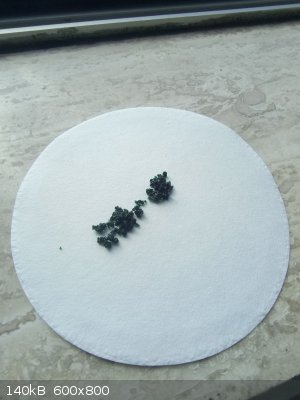
Another image is a mixture of Cr3+, Cl-, SO4(2-), NH4+ ions in water treated with a mixture of butyl acetate and ethanol.
All chloride is separated as a fine powder (it looks white on the photo but really it is light green) and the sulfate forms the alum with ammonia.
[Edited on 18-9-2021 by teodor]
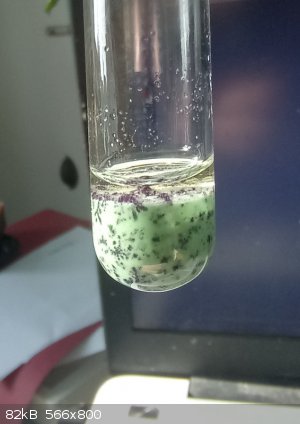
|
|
|